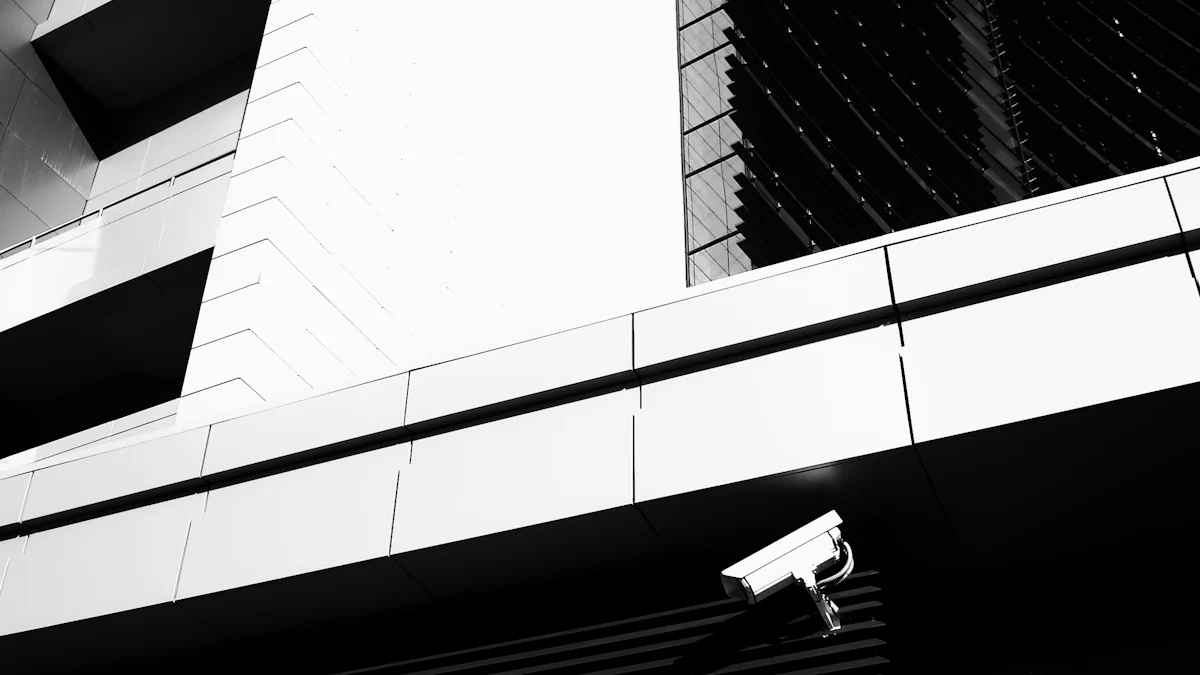What You Need to Know About EO/IR Camera Technology

EO/IR camera technology integrates electro-optical (EO) and infrared (IR) imaging capabilities. This dual-sensing approach enables you to capture clear images across various lighting conditions. You can depend on EO/IR cameras for effective monitoring, even in low-light environments or through visual obstructions such as smoke and fog.
The significance of EO/IR cameras in contemporary applications is immense. They enhance situational awareness and provide actionable intelligence for informed decision-making. Their versatility makes them ideal for military, industrial, and civilian use cases. As industries increasingly embrace this technology, you can anticipate substantial growth in its applications, especially in target tracking and detection.
Key Takeaways
EO/IR cameras use both light and heat to see. They work well in different light, even in complete darkness.
These cameras help people understand their surroundings. They give important information for military, security, and nature watching.
EO/IR systems have special parts like multiple sensors and AI. This makes them better at watching and making choices.
New improvements in EO/IR technology mean clearer images and new materials. This makes these systems more useful and effective.
Even though they are expensive and have some problems, EO/IR cameras are very important. They help in search and rescue, wildlife watching, and more.
Understanding EO/IR Camera Technology

What is EO/IR Technology?
EO/IR technology combines electro-optical and infrared capabilities to enhance imaging performance. This integration allows you to capture images in various lighting conditions. The electro-optical (EO) component detects visible light, while the infrared (IR) component senses thermal radiation. This dual approach provides you with a comprehensive view of your surroundings, even in low visibility situations.
How EO/IR Cameras Work
EO/IR cameras function by utilizing both EO and IR sensors. The EO sensors convert light into electronic signals, producing high-resolution images. In contrast, the IR sensors detect thermal radiation emitted by objects, converting it into electronic signals as well. This combination enables you to monitor environments effectively, regardless of lighting conditions.
Here are some key points about how these cameras operate:
IR cameras detect thermal radiation, allowing you to see heat signatures.
EO cameras capture light in the visible spectrum, providing clear images.
EO cameras operate within the visible light spectrum (400-700 nanometers) using CCD or CMOS sensors.
Key Components of EO/IR Systems
EO/IR systems consist of several essential components that work together to deliver superior imaging capabilities. These include:
Multi-Sensor Design: This combines EO cameras and IR cameras into a single system, enhancing versatility.
Pan-Tilt-Zoom (PTZ) Mechanisms: These allow for remote control, enabling wide-area surveillance and precise targeting.
AI and Analytics Integration: Features like motion tracking and target classification streamline operations.
Understanding these components helps you appreciate the advanced capabilities of EO/IR cameras. They provide you with the tools necessary for effective monitoring and decision-making across various applications.
Features of EO/IR Cameras
Imaging Capabilities of EO/IR Cameras
EO/IR cameras offer advanced imaging capabilities that set them apart from traditional cameras. The electro-optical sensors operate in the visible spectrum and slightly into the near-infrared. This allows you to capture high-resolution images under good visibility conditions. EO cameras excel at identifying specific objects and providing detailed, colorful images. This feature is crucial for applications requiring fine detail recognition, such as security systems. However, these cameras need adequate lighting to function effectively, making them less suitable for low-light environments.
Sensitivity and Resolution
Sensitivity and resolution significantly impact the performance of EO/IR cameras. High sensitivity enhances your ability to detect and differentiate thermal emissions. This capability is essential for identifying targets in complex backgrounds. For instance, you can easily spot a person in a crowded area using the thermal imaging capabilities of these cameras. Additionally, resolution is vital for capturing detailed images. You need high resolution to recognize fine details in both EO and IR imaging. This combination of sensitivity and resolution ensures effective monitoring and reconnaissance in various applications.
EO/IR Sensor Fusion and Integration
EO/IR sensor fusion enhances the overall performance of EO/IR systems. By integrating both electro-optical and infrared sensors, you gain several benefits:
Improved target identification
Effective operation under various visibility conditions
This fusion allows you to detect and identify threats in all visibility conditions. You receive a detailed 360-degree picture of your environment, which is invaluable for comprehensive surveillance. The integration of these sensors ensures that you can monitor effectively, regardless of the challenges posed by lighting or weather conditions.
Applications of EO/IR Cameras

Military and Defense Applications
EO/IR cameras play a crucial role in military and defense operations. Their advanced capabilities enhance situational awareness and operational effectiveness. Here are some primary military applications:
Application Type | Description |
|---|---|
Long-Range Surveillance | EO/IR systems monitor borders, airspace, and waters, detecting threats at significant distances. |
Targeting and Tracking | Integrated into weapon systems to identify, lock onto, and track targets, even in adverse weather or obscured environments. |
Reconnaissance | Provides detailed imagery of enemy positions, vehicles, or equipment, aiding in mission planning and execution. |
Perimeter Defense | Deployed around military bases or sensitive installations for 24/7 threat monitoring. |
Surveillance and Security Applications
In the realm of surveillance and security, EO/IR cameras offer unmatched capabilities. They help you monitor critical areas effectively. Here are some key uses:
Night Vision: Thermal imaging allows visibility in darkness by detecting heat signatures.
Defense and Military: EO/IR systems are used for long-range surveillance, targeting, and reconnaissance.
Security and Perimeter Protection: Monitors critical infrastructure and border security.
Maritime and Aerial Surveillance: Assists in search-and-rescue operations and anti-piracy efforts.
Law Enforcement and Civilian Use: Aids in public safety and environmental monitoring.
Additionally, these cameras can detect and neutralize drones by capturing their heat signatures. They integrate seamlessly with existing security systems, enhancing operational efficiency.
Environmental Monitoring Applications
EO/IR cameras also contribute significantly to environmental monitoring. They help you track changes in the environment effectively. Here are some applications:
These cameras track animal movements and monitor environmental changes such as forest fires.
By leveraging the capabilities of electro-optical and infrared technology, you can gain valuable insights into environmental conditions and wildlife behavior.
Search and Rescue Operations
EO/IR cameras play a vital role in search and rescue operations. These advanced systems help you locate survivors in challenging conditions. Whether you are searching in low visibility or open water, EO/IR cameras provide essential support.
You can rely on thermal imaging to detect heat signatures from people or vessels. This capability is crucial, especially in complete darkness or through fog. For instance, infrared sensors can identify individuals in distress, even when traditional methods fail.
Here are some key ways EO/IR cameras assist in search and rescue:
Application Type | Description |
|---|---|
Survivor Location | EO/IR cameras help locate survivors in low-visibility conditions. |
Environmental Data Overlay | Systems overlay real-time environmental data, aiding in tracking missing individuals. |
Long-Range Imaging | These cameras provide long-range imaging capabilities, allowing for broader search areas. |
The integration of stabilized EO/IR systems enhances your ability to monitor and assess situations effectively. You can use these systems on reconnaissance UAVs, which provide aerial views of search areas. This aerial perspective allows you to cover more ground quickly and efficiently.
Advancements in EO/IR Technology
Recent Innovations in EO/IR Systems
Recent advancements in EO/IR technology have significantly improved military and commercial applications. You can expect to see developments that address current operational challenges. Here are some key innovations:
Enhanced sensor resolution and thermal accuracy.
Improved analytical algorithms for better image processing.
The emergence of compact and efficient EO/IR Network Cameras.
A growing demand for larger and better focal plane arrays (FPAs).
These innovations ensure that EO/IR systems remain effective in various environments, meeting both military and commercial needs for cost-effectiveness and operational efficiency.
Future Trends in EO/IR Technology
Looking ahead, several trends will shape the future of EO/IR technology. You should keep an eye on these developments:
Advancements in sensor technology, including broadband EO/IR, multispectral, hyperspectral, and polarimetric sensors.
The introduction of new materials, such as carbon-based materials and metamaterials, which enhance EO properties.
The rise of computational imaging techniques that combine optics and processing for improved sensor functionality.
These trends promise to enhance the capabilities of EO/IR systems, making them even more versatile and effective.
Challenges and Opportunities in EO/IR Development
Despite the advancements, you should be aware of the challenges facing EO/IR technology. The high costs associated with developing and maintaining advanced systems can limit widespread adoption. Building these systems requires significant investment in sophisticated sensors, optics, and software algorithms. Additionally, maintenance can be expensive, especially for military units in remote areas.
Another challenge involves adversaries developing effective countermeasures. As EO/IR technology advances, so do techniques like infrared jamming and spoofing. To overcome these challenges, designers must leverage ongoing developments in new materials, micro-electromechanical systems (MOEMS), and artificial intelligence (AI) technologies.
By understanding these challenges and opportunities, you can appreciate the dynamic landscape of EO/IR technology and its potential impact on various applications.
EO/IR camera technology plays a vital role in various fields. These systems operate without needing sunlight or moonlight. They detect thermal radiation, allowing you to see in total darkness and through smoke or fog. This versatility makes them essential for detecting and tracking military targets, supporting high-resolution imaging, and monitoring adversary movements.
Key features include:
Night Vision: Thermal imaging for low-light conditions.
Defense and Military: Long-range surveillance and reconnaissance.
Security: Monitoring critical infrastructure and border security.
As you explore this technology, consider its potential in areas like search and rescue, wildlife monitoring, and medical diagnostics. The advancements in EO/IR systems promise exciting developments that can enhance your understanding and application of this innovative technology.
FAQ
What are the main advantages of EO/IR cameras?
EO/IR cameras provide versatile imaging capabilities. They operate effectively in various lighting conditions, including total darkness. Their dual-sensing technology enhances situational awareness, making them ideal for military, security, and environmental monitoring applications.
Can EO/IR cameras be used for civilian purposes?
Yes, EO/IR cameras have numerous civilian applications. You can use them for surveillance, search and rescue operations, wildlife monitoring, and environmental assessments. Their ability to function in low visibility makes them valuable tools in various fields.
How do EO/IR cameras differ from traditional cameras?
EO/IR cameras combine electro-optical and infrared technologies. Traditional cameras only capture visible light. EO/IR cameras detect thermal radiation, allowing you to see in darkness and through obstructions like smoke or fog, providing a comprehensive view of your surroundings.
Are EO/IR cameras expensive to maintain?
Maintaining EO/IR cameras can be costly due to their advanced technology. You must invest in high-quality sensors and optics. However, the benefits they provide in critical applications often justify the expense, especially in military and security contexts.
What challenges do EO/IR cameras face?
EO/IR cameras encounter challenges like high development costs and potential countermeasures from adversaries. Infrared jamming and spoofing techniques can hinder their effectiveness. Ongoing advancements in technology aim to address these challenges and improve system resilience.